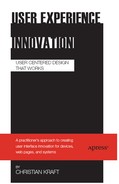Conclusion
I hope that you have found inspiration in many of the methods I have described in this book. User experience innovation will become the battleground in almost all consumer businesses within a few years. It has happened widely already within the web page design area, it has happened within the mobile phone area, and it will also happen in industries such as those involving washing machines, stereo and other music systems, remote controls, cars, and so forth. Customers will start to expect and demand reasonable user experiences for any product they purchase.
User experience innovation (especially for consumer-focused products) is nothing less than essential for survival! No company, be it a car manufacturer, a washing machine manufacturer, a social website company, or a mobile device manufacturer, will survive without focusing on user experience.
Consider Nokia. Nokia led the mobile industry for more than a decade—mainly due to a consistent flow of user experience improvements and innovations. Yet in only a few years' time, Nokia's position in the market dropped significantly, especially in the profitable smart phone sector, which is now controlled largely by Apple and Android-based products. Why the sudden drop in fortune? It was largely due to the lack of good user experience in Nokia's product line.
You will see the same trend repeat in other markets very soon. The world is changing. Customers, users, and people will demand and expect superior user experiences, and they will choose the products they purchase based on this. The change will come first in consumer-oriented products, but it will extend to professional-use products as well. If your company or organization is not currently looking into user experience innovations, you may already be too late. Focus on user experience innovation now.
User experience innovation is essential. Apple and Google have shown how to attack companies that were ruling the industry. They have won simply by applying relevant, novel, visible, and marketable user experience solutions and innovations to the market.
I will not claim that the methods described in this book are perfect, since perfect methods do not exist. But I can say that these methods have helped me personally to create more than 100 filed patents. They have helped me to create a number of truly successful user experience innovations for Nokia when Nokia was still seen as one of the top ten most innovative companies in the world. Begin trying out the methods, and over time you may adapt the methods for your specific product, or you may come up with your own additional methods or variants.
As an ending remark, I would like to emphasize three things that can help you create successful user experience innovation.
First is to involve the users. Find ways to involve users without spending a lot of time and money, and use existing insights and methods already available in your company. And find a way to involve your target users at every step of the iterative process—from getting input to verifying your solutions at all steps of the iterative innovation process.
The second thing is to focus on making your target users happy, or even make them fall in love with your product. Fixing small pain points in applications that are never used is a waste of time, so focus your efforts on making your core tasks and first impressions great. If you achieve those things, you will likely end up with a successful user experience.
The third thing that I want to emphasize is to make it fun to use your product, or at least to make it pain free. There are so many products in the world with a very poor user experience, spanning from TV remote controls to software packages to web pages. Create products that are fun to use. Success lies down that path.
—Christian Kraft, 2012
